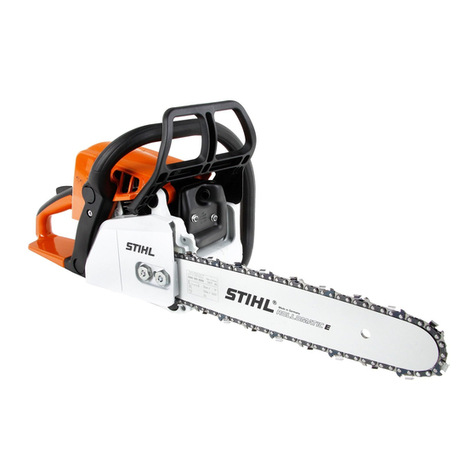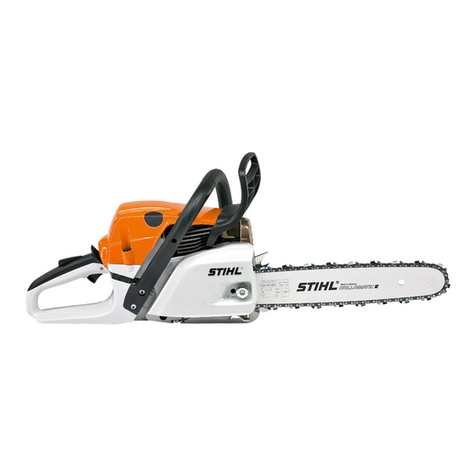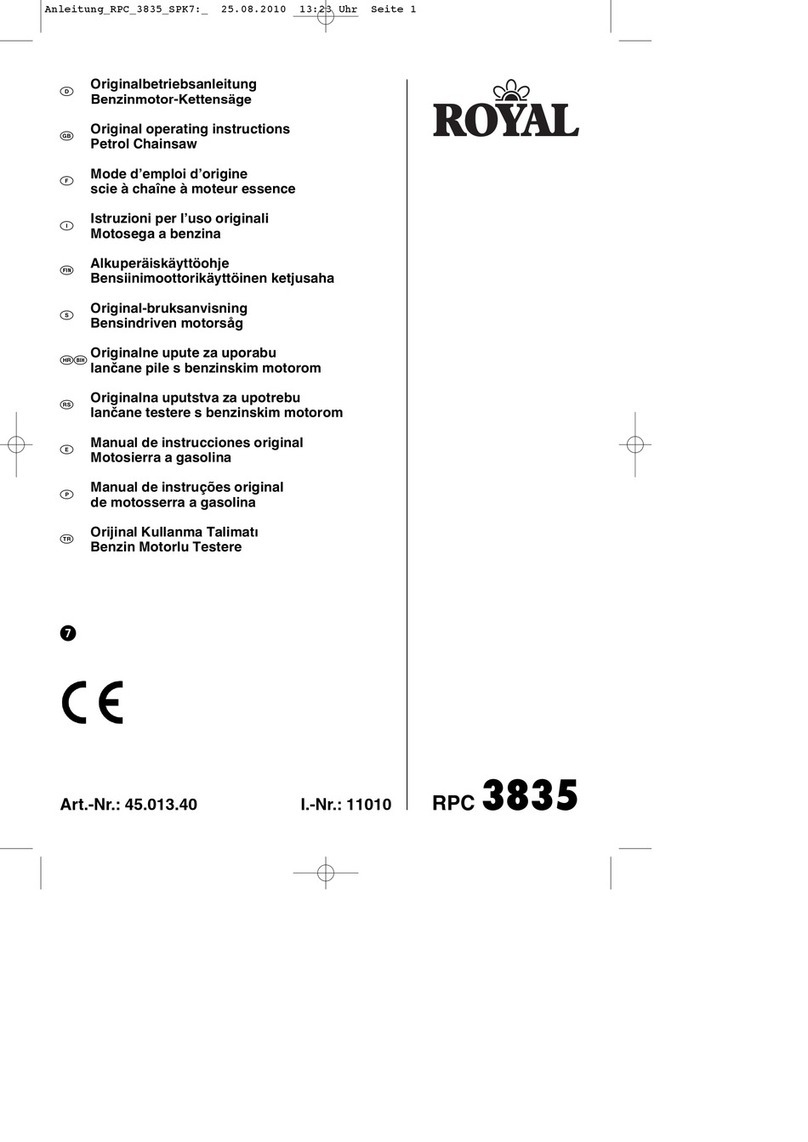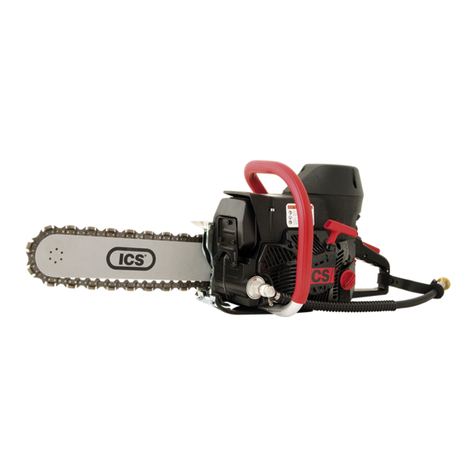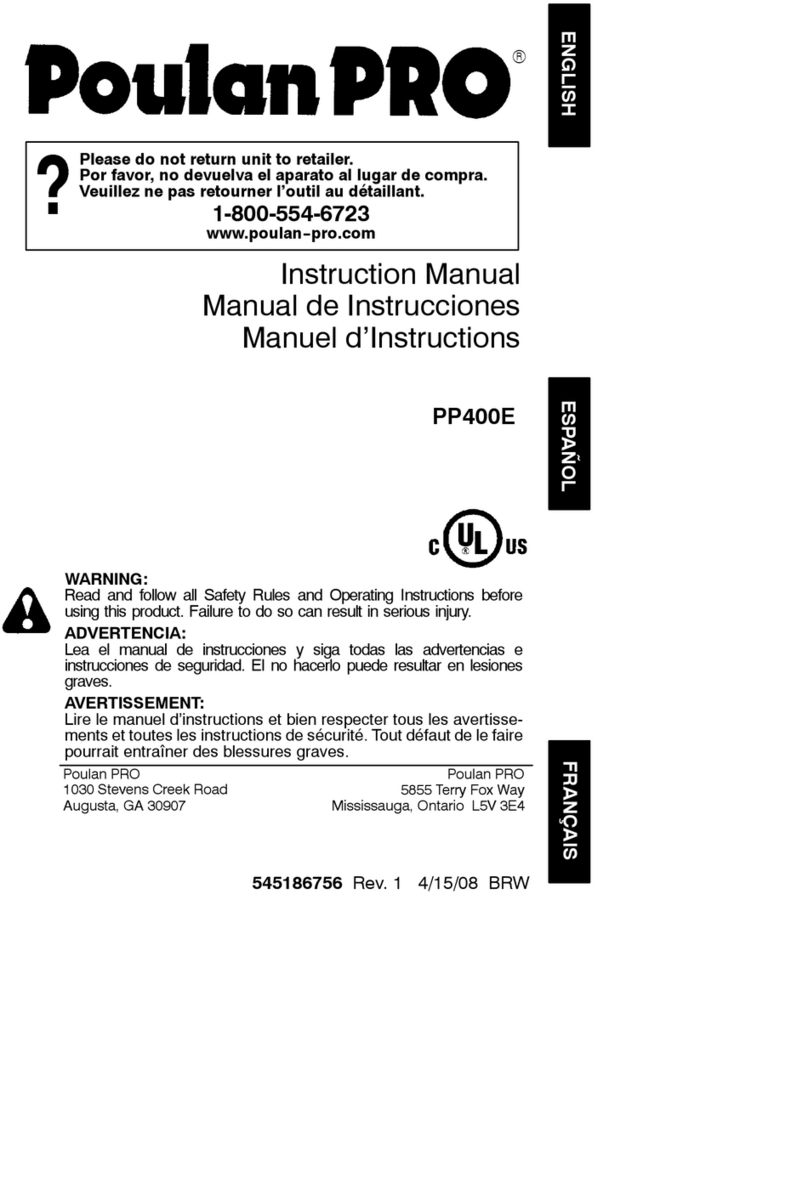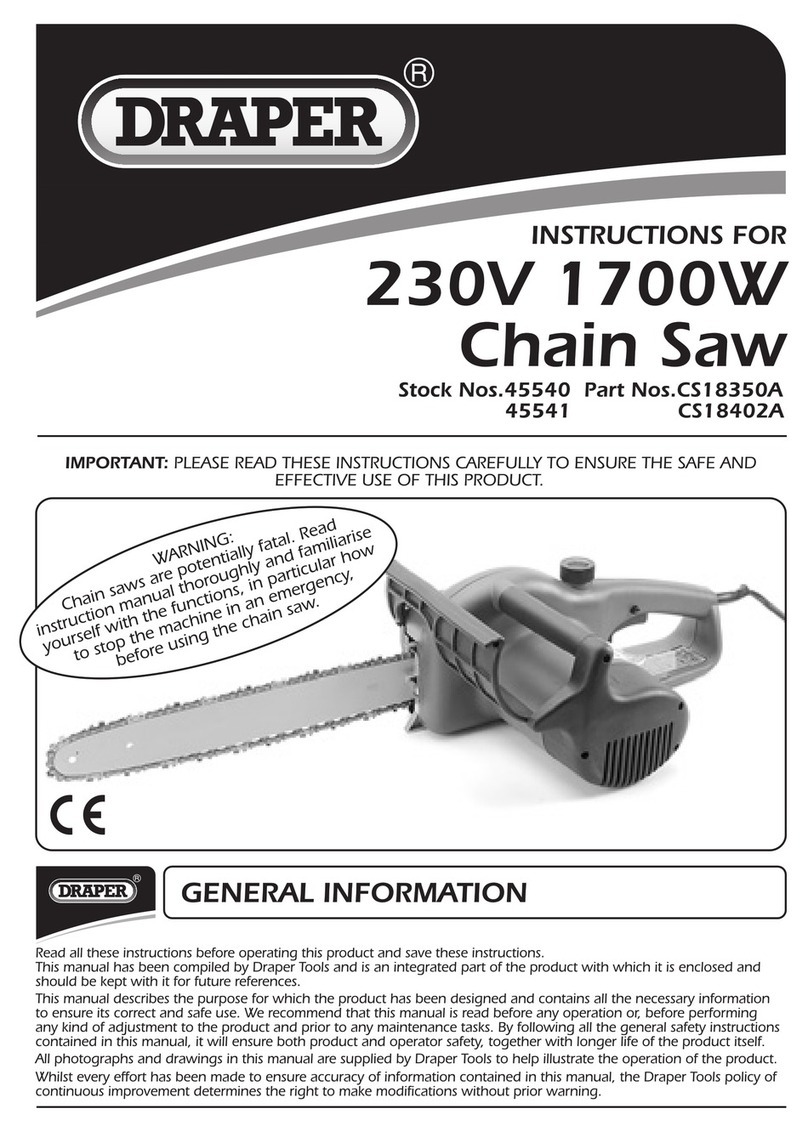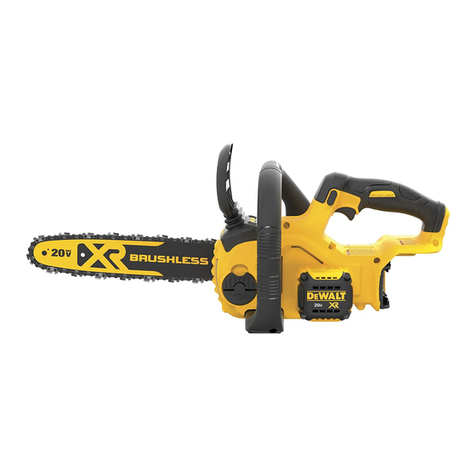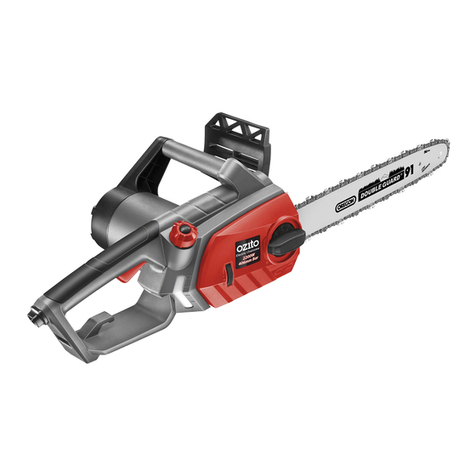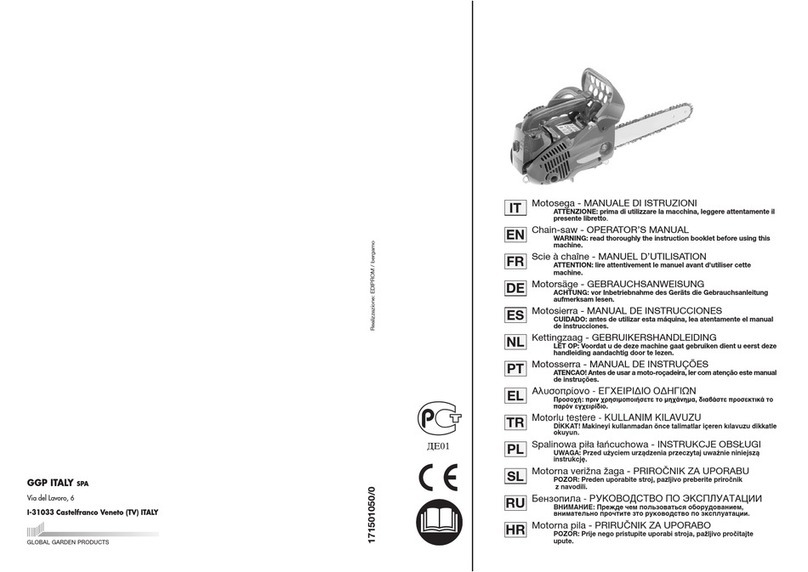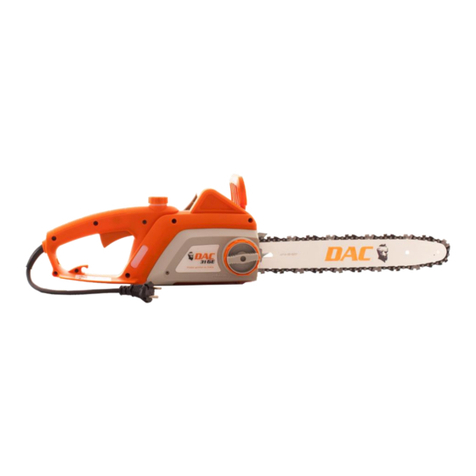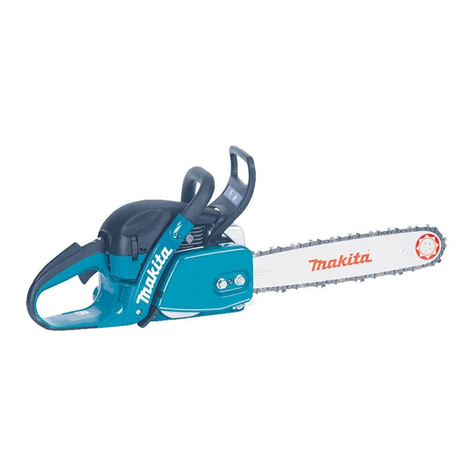Silvan Selecta Park 9717285 User manual


Pictogram illustration and explanation
1 2 3
4 5 6 7
1. Warning!
2. Unplug immediately if the power cord or plug becomes damaged!
3. Protect from water and damp conditions.
4. Read the operation manual before use and follow the warnings and safety instructions!
5. Wear protective helmet, goggles and earmuffs!
6. Always unplug the machine before doing any work on the chainsaw!
7. Always keep children and spectators well away from the working area.
Pictogram illustration and explanation
1 2 3
4 5 6 7
1. Warning!
2. Unplug immediately if the power cord or plug becomes damaged!
3. Protect from water and damp conditions.
4. Read the operation manual before use and follow the warnings and safety instructions!
5. Wear protective helmet, goggles and earmuffs!
6. Alwaysunplug the machine before doing any work on the chainsaw!
7. Always keep children and spectators well away from the working area.
GB
2
3
Illustration og forklaring af symboler
1 2 3
4 5 6 7
1. Advarsel!
2. Tag straks stikket ud,hvis netledningen eller stikket bliver beskadiget!
3. Beskyt mod forhold med vand og fugt.
4. Læs betjeningsvejledningen før brug,og følg advarslerne og sikkerhedsanvisningerne!
5. Bær beskyttelseshjelm,beskyttelsesbriller og høreværn!
6. Tag altid stikket fra maskinen ud,inden du begynder at arbejde på kædesaven!
7. Hold altid børn og tilskuere godt væk fra arbejdsområdet.

GB
2
3

4
5
GB

4
5
GB

6
7
GB

6
7
GB
1. Description (Fig 1)
1. Rear grip
2. Front grip
3. Front nger guard and chain brake
4. Saw chain
5. SDS system
6. Guide bar cover
7. Guide bar
8. Rear nger guard
9. Power cable
10. Claw stop
11. Safety lock-off button
12. Cable hook
13. ON/OFF switch
14. Oil tank cap
15. Oil gauge
16. Chain wheel
17. Guide bolt
18. Chain tensioning bolt
Safety instructions
The safety instructions must be observed when using the chainsaw. For your own safety and the safety
of others, please read this information carefully before using the chainsaw and keep it in a safe place for
reference. Use the chainsaw only to saw wood or objects made of wood. Any other types of use are at
your own risk and could be dangerous. The manufacturer cannot be held liable for damage caused by
improper or incorrect usage.
Safety instructions and accident prevention
To prevent the incorrect handling of the chainsaw, please read the operating instructions in their entirety
before using the chainsaw for the rst time. All the information on the handling of the chainsaw is relevant
to your personal safety. Ask a professional to show you how to use the chainsaw!
• Before plugging in, check the plug and cable for damage. If damage is discovered, have it repaired by
a specialist immediately. Never use a damaged cable, connection or plug or a power cable which does
not comply with the requirements. If the cable is damaged or severed, unplug immediately.
• Switch the chainsaw off before releasing the chain brake.
• Always wear goggles, helmet and protective gloves when working with the chainsaw. Also wear
earmuffs, which prevent damage to hearing.
• To prevent injury, wear tight-tting clothes and safety boots.
• Make sure you have a rm footing when working with the chain saw.
• Keep your place of work tidy.
• Always pull the plug out of the power socket before doing any work on the chainsaw.
• Only plug in when the chainsaw is switched off.
• The chainsaw must be used only by one person at a time. All other persons must stay clear of the
chainsaw’s area of swing. Children and pets in particular must be kept well away at all times.
• The saw must not be touching anything when it starts up.
• Hold the chainsaw rmly in both hands when working with it.
• The chain saw must not be operated by children or young people. The only exception to this rule is
young persons of 16 years and over who can use the chain saw under supervision as part of their
training. Lend the saw only to those persons who are familiar with this type of chainsaw and know how
to handle it. Always pass on the operating instructions together with the chainsaw.

• Make sure the chain saw is stored in a place inaccessible to children.
• The saw may be operated only by persons who are rested and in good health, i.e. in a good physical
condition. If you start to tire, have a break in time. The chainsaw should not be used after the consump-
tion of alcohol.
• Never expose the chainsaw to rain or bad weather. Make sure there is enough light at the place of work.
Do not use power tools in the vicinity of combustible liquids or gases.
• If the chainsaw is not being used for a while, it must be set aside in such a way that no other person is
endangered.
• Before making a cut, always set the claw stop before you start to saw.
• Remove the chainsaw from the wood only with the saw chain still running. Anyone who saws without a
stop can be pulled forwards.
• Never use the chainsaw when standing on a ladder, in a tree or in any other unstable places. Do not
attempt to saw with one hand.
• The power cable must always be behind the saw operator.
• The power cable must always lead away from the rear of the chainsaw.
• Use only original accessories.
• Chainsaws used outdoors must be connected up to an earth-leakag circuit-breaker.
• Do not overload your power tools. They run best and safest within given range of capacity.
• Always use the correct power tool. Do not use low-powered chainsaws for heavy jobs.
• Use the cable only for its proper purpose. Never carry your electric tool by its cable. Do not use the
cable to pull the plug out of the socket. Protect the cable from heat, oil and sharp edges.
• Use only authorized and accordingly labelled extension cables out of doors.
• Use a strong support when sawing converted timber and thin branches (saw-horse, Fig. 7b). Do not
stack the timber and do not have it held by a second person or with your foot.
• Logs must be secured in position before sawing.
• On sloping ground, always work facing upwards.
• Always set the claw stop before cross-cutting (see Fig. 7b). Only then switch on the chainsaw and start
sawing into the wood. Pull the chainsaw upwards at the rear and lead the direction with the front grip.
Use the claw stop as a fulcrum. To reposition for further cutting, interrupt the sawing process and exert
a slight pressure on the front grip. Pull the saw back a little, position the claw stop further down the cut
and pull up the rear grip (see Fig. 7a).
• Pull the saw out of the wood only when the saw chain is running.
• If you carry out several cuts, switch off the chain saw in-between.
• Plunge cuts and horizontal cuts may only be carried out by professionals (high risk of kick-back, see
Fig. 8).
• For horizontal cuts, position the smallest possible angle. This requires extreme caution, as the claw stop
can not be applied in this case.
• If the chain gets stuck when sawing with the upper side it may be thrust towards the operator. For this
reason you should saw wherever possible with the bottom side, as the chainsaw will then be thrust
away from the body towards the wood (see Fig, 9 and 10).
• Pay extra attention when cutting splintered wood. Sawed off pieces of wood may be catapulted in any
direction (risk of injury!)
• When lopping off branches, the chain saw should be supported wherever possible against the trunk.
Do not cut with the tip of the guide bar (risk of kick-back, see Fig. 8).
• Pay special attention to branches under tension. Do not cut through freely suspended branches from
underneath.
• Never stand on the trunk when loping off branches.
• This chainsaw should not be used for forest work, i.e. for felling and lopping off branches in the forest.
Because of the cable connection the saw operator does not have the necessary mobility and his safety
is not guaranteed!
• Always stand to the side of the tree being felled.
• When the tree is being felled, watch out for falling branches when stepping back.
8
9
GB

8
9
GB
• On slopes the saw operator should stand to the upper or left or right side the trunk or lying tree, never to
the bottom side.
• Watch out for trunks rolling towards you. Kick-back!
• The power saw is likely to recoil if the tip of the guide bar (especially the top quarter) accidentally
touches wood or any other solid objects. In this case the saw will move uncontrolled and will be hurled
towards the operator at full power (risk of injury!).
• Always take note of your surroundings and plan an escape route, in case of mishaps.
Transporting the chainsaw
Before transporting the chainsaw, always switch off and remove the plug from the power socket. Carry
the chain saw by the front handle, with the chain pointing away from your body. When transporting the
chain saw, always t the chain guard cover over the chain.
Special safety rules for chain saws:
• Keep all parts of your body away from the chain when operating the chain saw. Before starting the chain
saw, ensure that the chain is not in contact with anything.
• This chain saw is designed to be held with your right hand on the rear handle and your left hand on the
front handle. Do not reverse these hand positions as this will increase the risk of injury.
• Only hold the chain saw by its insulated handles. If you accidentally saw through a live wire, the metal
parts of the chain saw could cause electrical shock.
• Always wear safety goggles, protective gloves, helmet and hearing protection when operating the chain
saw.
• Never operate the chain saw when up in a tree or on a ladder. Always keep proper footing and only
operate the chain saw while standing secure on a level surface.
• Use extreme caution when:
a. cutting a branch that is under tension as it may spring back and strike you or throw the chain saw out
of control.
b. cutting brush or saplings which can catch the chain and pull you off balance.
• Do not overreach or cut above shoulder height as you may lose control of the chain saw in unexpected
situations.
• Only use replacement parts and chains as specied by the manufacturer. Incorrect replacement parts
may increase the risk of injury and the voiding of any product guarantee.
• For your safety, always follow the manufacturer’s guide for lubricating, tensioning the chain and
changing accessories. An improperly tensioned and lubricated chain can break or increase the risk of
kick-back.
• Keep handles dry and free from oil and grease to ensure a secure grip.
• This chain saw is for cutting wood only. Not to be used on any other material.
• Ensure that there are no nails or screws in the wood as this may break the chain or cause kick-back.
Preventing kick-back:
Kick-back may happen if the nose or tip of the saw touches an object or if the wood closes and pinches
the saw in the cut. In these cases, the saw may be thrown back towards the operator, with risk of injury
(“kick-back”).
You should not rely solely on the safety features on the chain saw but ensure your own safety.
Kick-back is a result of improper operation of the chain saw and can be avoided by following these steps:
• Always maintain a rm grip on both handles of the chain saw and position your arms and body so you
can resist the force of any kick-back.
• Never start cutting with the tip of the guide bar.
• Be careful, when continuing cuts you are already working on.
• Always start cuts with the chainsaw already running.
• Make sure that the saw chain is always properly sharpened.
• Never cut through more than one branch at a time. When lopping off branches, be careful not to touch

any other branches.
• When cross-cutting, pay attention to trunks standing very close to each other. If possible use a
saw-horse.
Correct way to hold the chain saw:
Before starting up
The voltage and current supply must comply with the ratings on the type plate. Before commencing work,
always check that the chainsaw works properly and is safe to operate. Check also that the chain lubrica-
tion and the oil gauge are in good working order (see Fig.4). When the oil lever is approx. 5 mm from the
bottom mark, you must top up with oil. When the oil level is above this mark you can work without worry.
Switch on the chain saw and hold it above the ground. Be careful not allow the chainsaw to touch the
ground. For safety reasons it is best to keep a clearance of at least 20 cm. If you now see growing traces
of oil, the chain lubrication system is working correctly. If there are no traces of oil at all, try cleaning the
oil outlet (Fig 2, C), the upper chain tensioning borehole (E) and the oil duct, or contact your Customer
Service. (Be sure to read the section “Filling in chain oil and chain lubrication” on this point). Check the
chain tension and retention if necessary (see the section “Tensioning the saw chain” on this point). Make
sure the chain brake is working properly (see also the section “Releasing the chain brake”).
Assembling the guide bar and saw chain (Fig 1, 2, 3)
The chainsaw must be unplugged.
Important: The front nger guard (3) must always be in the top (vertical) position (Fig. 5).
The guide bar and saw chain are supplied separately. To assemble, rst unscrew the lock knob (5) and
remove the guide bar cover (6). The chain tensioning bolt (18) must be in the center of the guide. If
necessary, adjust the chain tensioning bolt with the screw (16). To prevent injury on the sharp cutting
edges, always wear gloves when assembling, tensioning and checking the chain. Before assembling
the guide bar with the saw chain, check the cutting direction of the teeth! The running direction is
marked with an arrow on the Fig 1 (A). To determine the direction of cut, it may be necessary to turn over
the saw chain (4). Hold the guide bar (7) vertically with the tip pointing upwards and put on the saw chain
(4) beginning at the tip of the bar. Then assemble the guide bar with the saw chain as follows: Place
the guide bar with the saw chain on the guide bolt (17) and chain tensioning bolt (18). Place the saw
chain round the chain wheel (16) and make sure it is correctly mounted (see Fig.3). Place the guide bar
cover (6) on top and tighten gently with the lock knob (5) by hand. Now the saw chain has to be correctly
tensioned.
Tensioning the saw chain
Always pull the plug out of the power socket before doing any work on the chainsaw!
Wear safety gloves!
Make sure the saw chain (4) is inside the guide groove of the guide bar (7) (Fig.1 A)!
Turn the lock knob (5) clockwise by hand until the saw chain is correctly tensioned. Do not tension the
10
11
GB
b. cutting brush or saplings which can catch the chain and pull you off balance.
•Do not overreach or cut above shoulder height as you may lose control of the chain saw in
unexpected situations.
•Only use replacement parts and chains as specified by the manufacturer. Incorrect replacement
parts may increase the risk of injury and the voiding of any product guarantee.
•For your safety, always follow the manufacturer’s guide for lubricating, tensioning the chain and
changing accessories. An improperly tensioned and lubricated chain can break or increase the
risk of kick-back.
•Keep handles dry and free from oil and grease to ensure a secure grip.
•This chain saw is for cutting wood only. Not to be used on any other material.
•Ensure that there are no nails or screws in the wood as this may break the chain or cause
kick-back.
Preventing kick-back:
Kick-back may happen if the nose or tip of the saw touches an object or if the wood closes and pinches
the saw in the cut. In these cases, the saw may be thrown back towards the operator, with risk of injury
(“kick-back”).
You should not rely solely on the safety features on the chain saw but ensure your own safety.
Kick-back is a result of improper operation of the chain saw and can be avoided by following these steps:
•Always maintain a firm grip on both handles of the chain saw and position your arms and body so
you can resist the force of any kick-back.
•Never start cutting with the tip of the guide bar.
•Be careful, when continuing cuts you are already working on.
•Always start cuts with the chainsaw already running.
•Make sure that the saw chain is always properly sharpened.
•Never cut through more than one branch at a time. When lopping off branches, be careful not to
touch any other branches.
•When cross-cutting, pay attention to trunks standing very close to each other. If possible use a
saw-horse.
Correct way to hold the chain saw:

10
11
GB
chain too tightly. When cold, it should be possible to lift the chain in the middle of the guide bar approx
5 mm. Tighten the guide bar cover (6) securely.
When warm, the saw chain will expand and slacken and there is a danger of it jumping off the rail
altogether if improperly tensioned. Re-tension if necessary. If the saw chain is re-tensioned when hot,
it must be loosened again when the sawing work has been completed. Otherwise, the contraction which
takes place as the chain cools would result in excessively high tension. A new saw chain requires a
running-in period of approx .5 minutes. Chain lubrication is very important at this stage. After running in,
check chain tension and re-tension if necessary.
Filling in chain oil (Fig 4)
To prevent dirt getting inside the tank, clean the oil tank cap (21) before opening. Check the contents of
the oil tank during sawing work by checking the oil gauge (15). Close the oil tank cap tightly and wipe
away any spills.
Securing the extension lead (Fig 6)
Only use extension leads suitable for outdoor use. The cross section of the cable (max. length of exten-
sion cord: 75m) must be at least 1,5 mm2. Secure the chainsaw ex to the extension lead by inserting the
extension lead into the strain relief gap of the housing.
Extension leads longer than 30 m should have a cross section of at least 2,5 mm2to avoid reducing the
performance of the chainsaw.
Chain lubrication
To prevent excessive wear, the saw chain and guide bar must be evenly lubricated during operation.
Lubrication is automatic. Never work without chain lubrication. If the chain runs dry, the entire cutting
apparatus will quickly become severely damaged. It is therefore important to check both chain lubrication
and the oil gauge before every use (Fig. 4).
Never use the saw when the oil level is below the “Min.” mark.
• Min.: When only approx. 5 mm of oil is visible at the lower rim of the oil gauge (15), you must top up
with oil.
• Max.: Top up with oil until the window is full.
Checking the automatic lubrication
Before commencing work, check the automatic chain lubrication and oil gauge. Switch on the chain saw
and hold it above the ground. Be careful not to allow the chain saw to touch the ground. For safety
reasons it is best to keep a clearance of at least 20 cm. If you now see growing traces of oil, the chain
lubrication system is working correctly. If there are no traces of oil at all, try cleaning the oil outlet
(Fig 2, C), the upper chain tensioning borehole (E) and the oil duct, or contact your Customer Service.
Chain lubricants
The service life of saw chains and guide bars depends to a large extent on the quality of the lubricant
used. Old oil must not be used! Use only environment-friendly chain saw lubricant.
Guide bar
The guide bar (7) is subjected to especially severe wear and tear at the nose and the bottom. To avoid
one-sided wear and tear, turn the guide bar over every time when you sharpen the chain.
Chain wheel
The chain wheel (16) is subjected to especially high wear and tear. If you notice deep wear marks on the
teeth, the chain wheel must be replaced. A worn chain wheel curtails the service life of the saw chain.
Have the chain wheel replaced by a specialist dealer or your Customer Service.

Chain guard
The chain guard must be clipped onto the chain and sword as soon as the sawing work has been
completed and whenever the chainsaw has to be transported.
Chain brake
In the event of kick-back, the chain brake (3) will be actuated via the front nger guard. The front nger
guard is pushed forwards by the back of the hand and this causes the chain brake to stop the chain saw,
or rather the motor, within 0.12 seconds (Fig 5, I).
Releasing the chain brake (Fig 5)
To be able to use your chain saw again, you must release the saw chain brake. First switch off the chain-
saw and push the front nger guard (3) back into the vertical position until it locks in place (Fig 5, H). The
chain brake is now fully functional again.
Sharpening the saw chain
You can have your saw chain sharpened fast and correctly by specialist dealers, from whom you can also
obtain chain sharpening equipment to enable you to sharpen the chain yourself. Please follow the corre-
sponding operating instructions.
Take care of your tools. Keep your tools sharp and clean to enable you to work well and safely. Follow the
maintenance regulations and the instructions for changing tools
Starting up
Always wear safety goggles, ear muffs, protective gloves and heavy-duty work clothes!
Use the saw only with approved extension cables with the prescribed insulation and connections
designed for outdoor use (approved rubber-sheathed cables) which t the chainsaw plug. The chain saw
is equipped with a two-handed safety switch. The chainsaw works only when one hand holds the front
grip (2) and the other hand actuates the switch on the rear grip (1).
If the chainsaw does not run, the chain brake must be released at the front nger guard (3). Be sure to
read the sections “Chain brake” and “Releasing the chain brake “ on this point.
After switching on, the chainsaw will run immediately at high speed .
To switch off: Release either the ON/OFF switch (13) on the rear grip or the other switch (2) on the rear
grip.
The release of ON/OFF switch results the stop of the chainsaw within 2sec., and heavy sparkling. This is
normal and safe for the proper operation of the chainsaw.
After working with the chainsaw, you should always: Clean the saw chain and guide bar and replace
the chain guard.
Chainsaw protection
Never use the chainsaw in the rain or in damp conditions.
If the extension cable is damaged, pull the plug out of the power socket immediately. Never work
with a damaged cable.
Check the chainsaw for damage. Before using your tool again, check the safety devices or any slightly
damaged parts to ensure that they are in good working order. Make sure the moving parts are working
correctly. All the parts must be correctly assembled and meet all the conditions required to ensure that
the chainsaw works correctly. Any damaged safety devices and parts must be properly repaired or
replaced immediately by a Customer Service workshop, unless there are instructions to the contrary
in these operating instructions.
12
13
GB

12
13
GB
Tips on chain saw use
Sawing up wood (Fig 7a, 7b)
To saw up wood, please observe the safety regulations and proceed as follows: Make sure the wood to
be sawed cannot slip. Clamp short pieces of wood in place before sawing. Saw only wood or wooden
objects. When sawing, make sure that no stones or nails are touched as these could be thrown out and
damage the saw chain. Avoid bringing the running saw into contact with wire fences or the ground. When
lopping off branches, support the chainsaw as far as possible and do not saw with the tip of the guide bar.
Watch out for obstacles such as tree stumps, roots, ditches and hillocks as these could cause you to fall.
Remember:
The chainsaw must be running before it comes into contact with the wood.
To switch on: Press the safety lock-off (2) and ON/OFF switch on (13). Place the lowest claw (Fig 4, J)
on the wood . Raise the chain saw by the rear grip (2) and saw into the wood. Move the chain saw back
a little and place the claw further down. Be careful when sawing splintered wood as pieces of wood may
be ripped off.
Wood under tension
Fig, 11a: Top side of wood under tension
Danger: Tree will rear up!
Fig, 11b: Bottom side of wood under tension
Danger: Tree will move downwards!
Fig, 11c: Thick trunks and high tension
Danger: Tree will move suddenly and with immense force!
Fig, 11d: Both sides of trunk under tension
Danger: Tree will move sideways.
Felling trees
To fell trees, observe all the safety regulations and proceed as follows:
The chain saw may be used to fell only trees which are smaller in diameter than the length of the motor.
If the saw chain gets jammed, release it using a wooden wedge.
Remember:
Danger zone: Falling trees can bring down other trees with them. The danger zone is therefore twice the
length of the tree being felled. (Fig, 12)
Felling trees is dangerous and requires practice. If you are a beginner or inexperienced, do not try
to teach yourself but seek professional training. (Fig, 13)
Falling direction:
• Note that the falling direction can be severely inuenced by wind or weight / branch distribution
in the tree. In some cases, the tree should be guided by ropes or cables.
• First estimate the direction of fall, taking into account the centre of gravity of the crown and the wind
direction. The chain saw must be running before it comes into contact with the wood. Switch on the
chain saw. Saw an undercut in the tree in the direction of fall and then make a horizontal cut (back cut)
on the side opposite to the undercut.
• Make the undercut: This will give the tree a direction and guidance.
• Check the direction of fall: If you have to correct the undercut, always re-cut over the entire width.
• Call out “Timber!“
• Only now make the back cut, which must be higher than the sole of the undercut. Insert wedges in time.
• Leave the bridge in place as it will function as a hinge. If you cut through the bridge, the tree will fall
randomly.

• Fell the tree by driving a wedge into the back cut, not by sawing through it.
• When the tree falls, step back and watch the crown.
• Wait for the crown to stop swinging. Do not continue working under branches which have got stuck.
Do not fell trees:
• If you can longer distinguish details within the danger zone, e.g. owing to fog, rain, snow drifts or
twilight.
• If the direction of fall cannot be reliably estimated owing to wind or gusts of wind. Felling work on sloping
ground, black ice, frozen or dewy ground is safe only if you can get a rm foothold.
Maintenance and cleaning
Always pull the plug out of the power socket before doing any work on the chainsaw!
Keep the cooling vents on the motor housing clean and unobstructed at all times. Only the maintenance
work described in these operating instructions may be carried out. Any other maintenance work must be
carried out by our Customer Service. Do not modify the power saw in any way as this could jeopardize its
safety features. Should the chainsaw fail, despite our careful manufacturing and inspection procedures,
have it repaired by an authorized Customer Service work-shop. In the event of any inquiries and spare
parts orders, always quote the type designation and the parts number.
Storage
Keep your chain saw in a safe place. The unused chainsaw should be stored clean, on a at surface
and in a dry place which is inaccessible to children.
Technical data
Model number 9717285
Rated voltage (V) 230-240V~ 50Hz
Rated power (W) 2300
Blade length (mm) 400mm
Chain speed (m/s) 15m/s
Oil tank capacity (ml) 150ml
Chain brake time (s) 0.12
Sound pressure level dB(A) 106
Sound power level dB(A) 88
Vibration of rear handle (m/s2) 3.597
Vibration of front handle (m/s2) 3.707
Protection class II
Net weight (kg) 4.4KG
14
15
GB

14
15
GB
Fault Probable cause Remedy
Motor does not run No electricity Check outlet switch, socket,
cable and plug
If cable or plug is damaged,
have it repaired by Customer
Service
If the chain saw switch is
damaged it must be replaced
by Customer Service
Chain brake engaged Release chain brake
Carbon brush in motor worn Replace carbon brush
– contact Customer Service
Chain will not move Chain brake engaged Release chain brake
Poor cutting performance Blunt chain Sharpen the chain
Chain tension too loose or tight Correct the chain tension
Chain wrongly tted Check that the chain is tted
correctly
Chain jumps off sword Incorrect chain tension Check chain tension
Chain becomes hot Chain lubrication Check oil level
Check lubrication is working
Troubleshooting

16
17
DK
Illustration og forklaring af symboler
1 2 3
4 5 6 7
1. Advarsel!
2. Tag straks stikket ud, hvis netledningen eller stikket bliver beskadiget!
3. Beskyt mod forhold med vand og fugt.
4. Læs betjeningsvejledningen før brug, og følg advarslerne og sikkerhedsanvisningerne!
5. Bær beskyttelseshjelm, beskyttelsesbriller og høreværn!
6. Tag altid stikket fra maskinen ud, inden du begynder at arbejde på kædesaven!
7. Hold altid børn og tilskuere godt væk fra arbejdsområdet.
1. Beskrivelse (g. 1)
1. Bageste greb
2. Forreste greb
3. Forreste ngerskærm og kædebremse
4. Savkæde
5. SDS-system
6. Savsværdhylster
7. Savsværd
8. Bageste ngerskærm
9. Strømkabel
10. Stophage
11. Sikkerhedslåseknap
12. Kabelkrog
13. Tænd/sluk-kontakt
14. Oliebeholderdæksel
15. Oliestandsmåler
16. Kædehjul
17. Styrebolt
18. Kædespændingsbolt
Sikkerhedsanvisninger
Sikkerhedsanvisningerne skal overholdes i forbindelse med brug af kædesaven. Af hensyn til din egen og
andres sikkerhed skal du læse denne information grundigt, før du bruger kædesaven, og opbevare den
på et sikkert sted til senere brug. Brug kun kædesaven til at save træ eller genstande lavet af træ. Andre
anvendelser er for egen risiko og kan være farlig. Producenten kan ikke gøres ansvarlig for skader som
følge af ukorrekt eller forkert brug.
Sikkerhedsanvisninger og forebyggelse af ulykker
For at undgå forkert håndtering af kædesaven bedes du læse hele betjeningsvejledningen, før du bruger
kædesaven første gang. Alle oplysninger om håndtering af kædesaven er relevante for din personlige
Pictogram illustration and explanation
1 2 3
4 5 6 7
1. Warning!
2. Unplug immediately if the power cord or plug becomes damaged!
3. Protect from water and damp conditions.
4. Read the operation manual before use and follow the warnings and safety instructions!
5. Wear protective helmet, goggles and earmuffs!
6. Alwaysunplug the machine before doing any work on the chainsaw!
7. Always keep children and spectators well away from the working area.

16
17
DK
sikkerhed. Bed en fagkyndig person om at vise dig, hvordan du bruger kædesaven!
• Før tilslutning til stikkontakten, skal stikket og kablet kontrolleres for skader. Hvis der opdages skader,
skal de repareres af en specialist med det samme. Brug aldrig et kabel, en forbindelse, eller et stik, der
er beskadiget, eller et strømkabel der ikke opfylder kravene. Hvis kablet er blevet beskadiget eller revet
op, skal stikket straks tages ud.
• Sluk for kædesaven, før kædebremsen frikobles.
• Bær altid beskyttelsesbriller, sikkerhedshjelm og sikkerhedshandsker ved arbejde med kædesaven.
Bær også høreværn, der forhindrer høreskader.
• For at undgå personskader skal du bære tætsiddende tøj og sikkerhedsstøvler.
• Kontroller, at du har et godt fodfæste, når du arbejder med kædesaven.
• Hold arbejdsstedet ryddeligt.
• Træk altid stikket ud af stikkontakten, før du udfører arbejde på kædesaven.
• Sæt kun stikket i stikkontakten, når kædesaven er slukket.
• Kædesaven må kun anvendes af én person ad gangen. Alle andre personer skal holde sig uden for
kædesavens svingområde. Især skal børn og husdyr holdes langt væk hele tiden.
• Saven må ikke røre ved noget, når den startes.
• Hold kædesaven fast med begge hænder, når du arbejder med den.
• Kædesaven må ikke betjenes af børn eller unge. Den eneste undtagelse fra denne regel er unge på
16 år og derover, som kan bruge kædesaven under opsyn som en del af deres uddannelse. Udlån kun
saven til personer, som har kendskab til denne type af kædesav og ved, hvordan den skal håndteres.
Sørg altid for at videregive betjeningsvejledningen sammen med kædesaven.
• Sørg for, at kædesaven opbevares på et sted, der er utilgængeligt for børn.
• Saven må kun betjenes af personer, som er udhvilede og have et godt helbred, det vil sige være i god
kondition. Hvis du begynder at blive træt, skal du holde en pause i tide. Kædesaven må ikke bruges
efter indtagelse af alkohol.
• Kædesaven må aldrig udsættes for regn eller dårligt vejr. Sørg for, at der er lys nok på arbejdsstedet.
Brug ikke maskinværktøj i nærheden af brændbare væsker eller gasser.
• Hvis kædesaven ikke skal bruges et stykke tid, skal den opbevares, så andre personer ikke udsættes
for fare.
• Før du foretager en skæring, skal du altid indstille stophagen, før du begynder at save.
• Tag kun kædesaven væk fra træet, når savkæden stadig kører. Hvis man saver uden stop, kan man
blive trukket fremad.
• Brug aldrig kædesaven stående på en stige, i et træ eller på andre ustabile steder. Forsøg ikke at save
med én hånd.
• Strømkablet skal altid være bag den, der betjener saven.
• Strømkablet skal altid føres væk fra kædesavens bagende.
• Brug kun originalt tilbehør.
•Kædesave, der bruges udendørs, skal være tilsluttet til en fejlstrømsafbryder.
• Dit maskinværktøj må ikke overbelastes. Det kører bedst og sikrest inden for deres angivne kapacitets-
område.
• Brug altid det korrekte maskinværktøj. Brug ikke mindre kædesave med for lidt kraft til tunge opgaver.
• Brug kun kablet til det tilsigtede formål. Elværktøjet må aldrig bæres i dets kabel. Brug ikke kablet til at
trække stikket ud af stikkontakten. Beskyt kablet mod varme, olie og skarpe kanter.
• Brug kun godkendte og dertil mærkede forlængerkabler udendørs.
• Brug et kraftigt underlag, når du saver tømmer og tynde grene (savbuk, g. 7b). Tømmeret må ikke
stables og må ikke holdes af en anden person eller med foden.
• Kævler skal sikres i en fast position inden savning.
• På skrånende terræn skal du altid arbejde, så du står vendt opad mod stigningen.
• Indstil altid stophagen før overskæring (se g. 7b). Først derefter må kædesaven tændes, og du kan
begynde at save ind i træet. Træk kædesav opad i bagenden, og styr retningen med det forreste hånd-
tag. Brug stophagen som omdrejningspunkt. Når du skal ændre stilling for yderligere skæring, skal du

18
19
DK
afbryde savningen og trykke let på det forreste håndtag. Træk saven lidt tilbage, anbring stophagen
længere nede i skæret, og træk det bageste håndtag op (se g. 7a).
● Saven må kun trækkes ud af træet, mens savkæden kører.
● Hvis du udfører ere skæringer, skal kædesaven slukkes mellem hver skæring.
● Indstikningssavning og vandret savning må kun udføres af fagfolk (høj risiko for tilbageslag, se g. 8).
● Ved vandret skæring skal vinklen være mindst mulig. Dette kræver stor forsigtighed, da stophage ikke
kan anvendes i dette tilfælde.
● Hvis kæden sætter sig fast under savning med oversiden, kan den blive slynget mod brugeren. Derfor
skal du så vidt muligt save med undersiden, fordi kædesaven så vil blive kastet væk fra kroppen mod
træet (se g. 9 og 10).
● Vær ekstra opmærksom ved savning i splintret træ. Gennemsavede træstykker kan blive slynget i alle
retninger (risiko for personskade!)
● Ved afkapning af grene skal kædesaven så vidt muligt støttes mod stammen. Undlad at skære med
spidsen af savsværdet (risiko for tilbageslag, se g. 8).
● Vær særligt opmærksom på grene, der er i spænd. Lad være med at skære gennem frithængende
grene nedefra.
● Stå aldrig på stammen under afkapning af grene.
● Denne kædesav må ikke bruges til skovarbejde, det vil sige fældning og afkapning af grene i skoven.
På grund af kabelforbindelse har brugeren ikke tilstrækkelig bevægelsesfrihed, og brugerens sikkerhed
er ikke garanteret!
● Stå altid ved siden af det træ, der fældes.
● Mens træet fældes, skal du holde øje med nedfaldne grene, når du træder tilbage.
● På skråninger skal savens bruger stå øverst til venstre eller højre for stammen eller det liggende træ,
aldrig under det.
● Hold øje med stammer, der kan komme rullende mod dig. Tilbageslag!
● Kædesaven vil sandsynligvis slå tilbage, hvis spidsen af savsværdet (især den øverste fjerdedel) ved
et uheld skulle komme i kontakt med træ eller andre faste genstande. Hvis det er tilfældet, vil saven
bevæge sig ukontrolleret og blive slynget mod brugeren for fuld kraft (risiko for personskade!).
● Vær altid opmærksom på dine omgivelser, og planlæg en ugtvej i tilfælde af uheld.
Transport af kædesaven
Før du transporterer kædesaven, skal du altid slukke den og tage stikket ud af stikkontakten. Kædesaven
skal bæres i det forreste håndtag med kæden pegende væk fra kroppen. Under transport af kædesaven
skal kædeskærmkappen altid sættes over kæden.
Særlige sikkerhedsforanstaltninger for kædesave:
• Hold alle kropsdele på afstand af kæden, mens saven betjenes. Før kædesaven startes, skal du
kontrollere, at kæden ikke er i kontakt med noget.
• Kædesaven er konstrueret til at blive holdt med højre hånd på bageste håndtag og venstre hånd på
forreste håndtag. Byt ikke om på disse håndstillinger, da det vil øge risikoen for at komme til skade.
• Hold kun kædesaven på dens isolerede håndtag. Hvis du ved et uheld saver gennem en strømførende
ledning, kan kædesavens metaldele forårsage elektrisk stød.
• Bær altid sikkerhedsbriller, beskyttelseshandsker, hjelm og høreværn, når du arbejder med kædesaven.
• Brug aldrig kædesaven, mens du er oppe i et træ eller står på en stige. Sørg for altid at have godt fod-
fæste, og brug kun kædesaven, mens du står sikkert på et plant underlag.
• Udvis ekstrem forsigtighed i disse situationer:
a. overskæring af en gren, der er i spænd, da den kan slå tilbage og ramme dig eller slynge kædesaven
ud af kontrol.
b. overskæring af buske eller små træer, der kan gribe fat i kæden og trække dig ud af balance.
• Ræk ikke for langt, og skær ikke over skulderhøjde, da du kan miste kontrollen over kædesaven i
uvante situationer.
• Brug kun reservedele og kæder, som er speciceret af producenten. Forkerte reservedele kan øge

18
19
DK
risikoen for personskader og gøre en produktgaranti ugyldig.
• Af hensyn til din sikkerhed skal du altid følge producentens vejledning om smøring, stramning af kæden
og udskiftning af tilbehør. En forkert strammet eller forkert smurt kæde kan gå i stykker og øge risikoen
for tilbageslag.
• Hold håndtagene tørre og fri for olie og fedt for at sikre et fast greb.
• Denne kædesav er kun beregnet til skæring i træ. Den må ikke bruges til andre materialer.
• Sørg for, at der ikke er søm eller skruer i træet, da det kan ødelægge kæden eller forårsage tilbageslag.
Forhindring af tilbageslag:
Tilbageslag kan forekomme, hvis savens næse eller spids kommer i berøring med en genstand, eller
hvis træet spænder til og klemmer saven i savsporet. I disse tilfælde kan saven blive slynget tilbage mod
brugeren med risiko for personskade (“tilbageslag”).
Du bør ikke kun sætte din lid til kædesavens sikkerhedsfunktioner, men også aktivt sørge for din egen
sikkerhed.
Tilbageslag er et resultat af forkert betjening af kædesaven og kan undgås ved at følge disse trin:
• Hav altid et fast greb i begge håndtag på kædesaven og anbring armene og kroppen, så du kan modstå
kraften fra et tilbageslag.
• Begynd aldrig at save med spidsen af sværdet.
• Vær forsigtig, når du fortsætter en skæring, som du allerede arbejder på.
• Start altid en skæring med kædesaven kørende.
• Sørg for, at savkæden altid er korrekt skærpet.
• Skær aldrig gennem mere end én gren ad gangen. Ved afkapning af grene skal du passe på ikke at
berøre andre grene.
• Ved overskæring skal du være opmærksom på stammer, der står meget tæt på hinanden. Brug om
muligt en savbuk.
Korrekt måde at holde kædesaven på:
Før start
Både spændings- og strømforsyning skal overholde angivelserne på typeskiltet. Før arbejdet påbegyn-
des, skal du altid kontrollere, at kædesaven fungerer korrekt og er sikker at betjene. Kontroller også at
kædesmøringen og oliemåleren er i god stand (se g. 4). Når oliestanden er ca. 5 mm fra det nederste
mærke, skal du efterfylde med olie. Når oliestanden er over dette mærke, kan du arbejde uden bekym-
ringer. Tænd for kædesaven og hold den over jorden. Vær forsigtig med ikke at lade kædesaven røre
jorden. Af sikkerhedsgrunde er det bedst at holde en afstand på mindst 20 cm. Hvis du nu ser spor af
olie, fungerer kædesmøringssystemet korrekt. Hvis der slet ikke er spor af olie i, så prøv at rense olie-
udgangen (g. 2, C), det øverste borehul til kædestramning (E) og oliekanalen, eller kontakt kunde-
service. (Husk at læse afsnittet “Påfyldning af kædeolie og kædesmøring” om dette). Kontroller kæde-
stramningen og kædeholdet, hvis det er nødvendigt (se afsnittet “Stramning af savkæden” om dette).
Kontroller, at kædebremsen fungerer korrekt (se også afsnittet “Frikobling af kædebremsen”).
Montering af savsværdet og savkæden (g. 1, 2, 3)
Stikket til kædesaven skal være trukket ud af stikkontakten.
Vigtigt: Den forreste ngerskærm (3) skal altid være i øverste position (lodret) (g. 5).
b. cutting brush or saplings which can catch the chain and pull you off balance.
•Do not overreach or cut above shoulder height as you may lose control of the chain saw in
unexpected situations.
•Only use replacement parts and chains as specified by the manufacturer. Incorrect replacement
parts may increase the risk of injury and the voiding of any product guarantee.
•For your safety, always follow the manufacturer’s guide for lubricating, tensioning the chain and
changing accessories. An improperly tensioned and lubricated chain can break or increase the
risk of kick-back.
•Keep handles dry and free from oil and grease to ensure a secure grip.
•This chain saw is for cutting wood only. Not to be used on any other material.
•Ensure that there are no nails or screws in the wood as this may break the chain or cause
kick-back.
Preventing kick-back:
Kick-back may happen if the nose or tip of the saw touches an object or if the wood closes and pinches
the saw in the cut. In these cases, the saw may be thrown back towards the operator, with risk of injury
(“kick-back”).
You should not rely solely on the safety features on the chain saw but ensure your own safety.
Kick-back is a result of improper operation of the chain saw and can be avoided by following these steps:
•Always maintain a firm grip on both handles of the chain saw and position your arms and body so
you can resist the force of any kick-back.
•Never start cutting with the tip of the guide bar.
•Be careful, when continuing cuts you are already working on.
•Always start cuts with the chainsaw already running.
•Make sure that the saw chain is always properly sharpened.
•Never cut through more than one branch at a time. When lopping off branches, be careful not to
touch any other branches.
•When cross-cutting, pay attention to trunks standing very close to each other. If possible use a
saw-horse.
Correct way to hold the chain saw:

20
21
DK
Savsværd og savkæde leveres separat. Ved montering skal du først skrue låseknappen (5) af og fjerne
savsværdhylsteret (6). Kædestrammebolten (18) skal være i midten af styret. Juster om nødvendigt
kædestrammebolten med skruen (16). For at undgå at skære dig på de skarpe kanter skal du altid bruge
handsker ved montering, stramning og kontrol af kæden. Før montering af savsværdet med savkæden
skal tændernes skæreretning kontrolleres! Køreretningen er markeret med pil på g. 1 (A). For at
bestemme skæreretningen kan det være nødvendigt at vende savkæden (4). Hold savsværdet (7) lodret
med spidsen pegende opad, og sæt savkæde (4) på, begynd ved spidsen af sværdet. Saml derefter
savsværdet med savkæden som følger: Anbring savsværdet med savkæden på styrebolten (17) og
kædestrammebolten (18). Før savkæden rundt om kædehjulet (16), og kontroller, at den er monteret
korrekt (se g. 3). Anbring savsværdhylsteret (6) ovenpå, og spænd forsigtigt med låseknappen (5) med
hånden. Nu skal kæden strammes korrekt.
Stramning af savkæden
Træk altid stikket ud af stikkontakten, før du udfører arbejde på kædesaven!
Brug beskyttelseshandsker!
Kontroller, at savkæden (4) ligger inde i styrerillen i savsværdet (7) (g. 1 A)!
Drej låseknappen (5) med hånden med uret, indtil savkæden er strammet korrekt. Kæden må ikke
strammes for meget. Når kæden er kold, skal det være muligt at løfte kæden på midten af savsværdet
ca. 5 mm. Spænd savsværdhylsteret (6) godt fast.
Når kæden er varm, udvides og slækkes den, så der er risiko for, at den hopper helt ud af skinnen, hvis
den ikke er tilstrækkeligt spændt. Efterstram den om nødvendigt. Hvis savkæden skal efterstrammes,
mens den er varm, skal den løsnes igen efter afsluttet savning. Ellers kan sammentrækningen på grund
af kædens nedkøling resultere i for kraftig stramning. En ny kæde kræver en indkøringsperiode på ca.
et halvt minut. Kædesmøring er meget vigtig på dette tidspunkt. Efter indkøring skal kædestramningen
kontrolleres. Efterspænd om nødvendigt.
Påfyldning af kædeolie (g. 4)
For at forhindre snavs i oliebeholderen, skal dens dæksel (21) kontrolleres før åbning. Kontroller indhold-
et af oliebeholderen under savning ved at kontrollere oliestandsmåleren (15). Luk oliebeholderens dæk-
sel tæt, og fjern eventuelt spild.
Sikring af forlængerledning (g. 6)
Brug kun forlængerledninger, der er egnet til udendørs brug. Kablets tværsnit (max. længde af forlæn-
gerledning: 75 m) skal være mindst 1,5 mm2. Fastgør kædesavens ex til forlængerledningen ved at
indsætte forlængerledningen i trækaasteråbningen i huset.
Forlængerledninger længere end 30 m skal have et tværsnit på mindst 2,5 mm2for at undgå nedsat
ydeevne for kædesaven.
Kædesmøring
For at undgå unødvendig slitage skal savkæden og savsværdet smøres jævnt under drift.
Smøringen sker automatisk. Arbejd aldrig uden kædesmøring. Hvis kæden løber tør, vil hele skære-
apparatet hurtigt blive alvorligt beskadiget. Det er derfor vigtigt at kontrollere både kædesmøringen og
oliestandsmåleren før hver brug (g. 4).
Brug aldrig saven, hvis oliestanden er under “Min.”-mærket.
• Min.: Når kun ca. 5 mm af olien er synlig ved oliestandsmålerens (15) nederste kant, skal du efterfylde
med olie.
• Max.: Efterfyld med olie, indtil vinduet er fuldt.
Table of contents
Languages:
